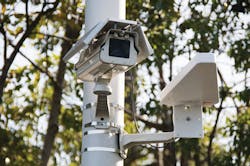MicroPower makes strides towards widespread adoption in perimeter security market
MicroPower Technologies, a Calif.-based provider of wireless, solar-powered surveillance solutions, announced on Wednesday that it has developed a new range-booster antenna that can be added to its Helios surveillance system to increase signal sensitivity by 16 times, thereby extending the distance between the hub and the hub antenna up to 200 feet and offering better performance for the user.
The addition of this range-booster antenna to their product portfolio is just the latest step in the evolution of MicroPower from being a conceptual technology that could only be used in a few niche applications to being a commercially viable product with mass market appeal across the industry.
Former Avigilon executive Dave Tynan, who recently joined MicroPower as vice president of global marketing and business development, credits the company’s senior leadership team and their attentiveness to the concerns of customers to the success they’ve had thus far.
“Many of the security and surveillance folks have pursued – I would call them relatively expensive options – to address perimeter protection and event management. With MicroPower’s unique solutions, they now have the opportunity to place an offering in the marketplace that re-imagines the ability to gather indisputable evidence in far-reaching and geographically dispersed perimeter and outdoor environments,” Tynan explained.
Tynan said that one of the company’s customers, American Airlines Center in Dallas, was able to justify the cost of deploying the Helios system in just two events. “I think one thing we have to do very soon is convey the value of the system to others who are under pressure to justify additional capital investments with quantitative return on investment,” he said.
Tynan said that MicroPower will soon begin holding monthly web conferences with industry leaders, which will help the company define its roadmap for future products and features, as well as ensure their agility in the marketplace.
“This voice of the customer forum is one that I’ve used in the past successfully and these forums and their efforts will drive and evolve the strategies and the path of the company. Moving forward, our products and solutions will be defined by the market need and I’m really excited about that. I think (CEO) Aaron (Tankersley) will facilitate that and he’s shown a great deal of excitement for it,” Tynan said.
Tynan believes that the future success of MicroPower will depend on how good of a job they do in helping to educate the industry about the benefits of the company’s technology.
“Because the Helios system can literally be an extension of any outdoor system, the expectation is that the solar-powered, wireless system will have a very broad application with legacy systems. In other words, our growth is really going to be subject to an education to the systems integrators and the users that their existing VMS and their existing hardware they have on site can be added to and expanded because the Helios system really is a ubiquitous offering that a systems integrator can use for their entire install base,” added Tynan. “Due to the system’s robust interoperability, it’s very easy to deploy. I think one of the challenges we’re going to have is again that paradigm shift of helping people understand that they can change the perspective of a surveillance camera and now they’ll have the ability to strap these cameras to anywhere in the perimeter; whether it’s on a facility, whether it’s on a pole, it can literally be on a palm tree if that’s what’s available to attach the cameras to.”
When it comes to the market, in general, Tynan said that he continues to see an increase in the proliferation of surveillance cameras across vertical markets and a need to show ROI for those camera purchases , which bodes well for MicroPower.
“I see organizations beginning to recognize that the level of forensic evidence is improving dramatically or can be improved. The challenge is always the return on investment,” said Tynan. “In terms of a megatrend, I see and I hear about organizations that are adding a business element to their surveillance and security departments because corporations are beginning to set expectations that the surveillance and security department needs to be able to justify their own existence by way of adding to the bottom line of the corporation.”
About the Author
Joel Griffin
Editor-in-Chief, SecurityInfoWatch.com
Joel Griffin is the Editor-in-Chief of SecurityInfoWatch.com, a business-to-business news website published by Endeavor Business Media that covers all aspects of the physical security industry. Joel has covered the security industry since May 2008 when he first joined the site as assistant editor. Prior to SecurityInfoWatch, Joel worked as a staff reporter for two years at the Newton Citizen, a daily newspaper located in the suburban Atlanta city of Covington, Ga.

